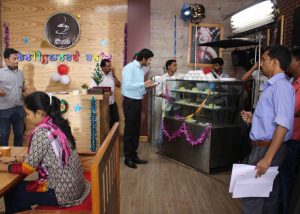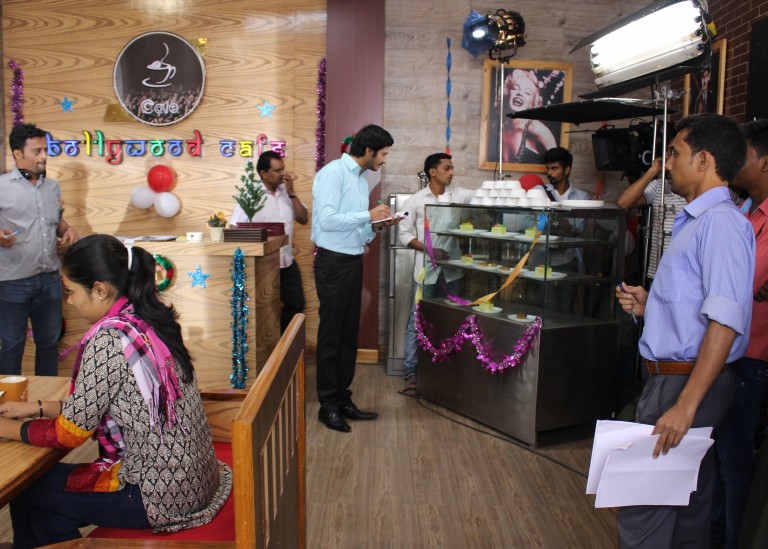
Filming at the Bollywood Cafe.
Frances Nelson McSherry, Teaching Professor in the Department of Theatre and professional costume designer, recently embarked on a trip of a lifetime to India, where she spent a week studying Bollywood costume design. From participating in a Bollywood dance lesson to visiting a private movie studio, the “From Hollywood to Bollywood Tour” was full of rich experiences that McSherry is excited to apply to her work in the classroom.
Below, she describes some of the trip’s highlights in her own words:
“The Chandi Chowk Bazaar, built in the 17th century, is one of the busiest and most popular markets in Old Delhi. We visited multiple shops filled with beautiful silk saris, leather goods, trimmings, buttons, and gold and silver jewelry. The busy, narrow streets are also featured in many Bollywood movies.

Chandi Chowk Bazaar.
We participated in a Bollywood dance lesson at a professional dance studio. We dressed in traditional costumes and instructors taught us various types of traditional dance movements which are featured in Indian weddings and Bollywood movies. I gained new appreciation for the energetic and joyful moves which seem effortless when performed by professional dancers.
We watched a spectacular live Bollywood musical with hundreds of performers and massive sets and lavish costumes. Afterwards, we toured the backstage area and watched the stage crew changeover from one show to another. An added bonus was a meeting in the dressing rooms with several of the stars of the show. These talented performers spoke of the years of dance training necessary to be cast in a big musical – and then the additional years needed perfecting their skills in order to work their way up from chorus members to star performers. Although these artists also are excellent actors and singers, dancing skills are the most important consideration when casting a big Bollywood musical.

Backstage at musical.
In Cochin in the state of Kerala at the southern end of the country, we studied the intricacies of Kathakali dance, one of the major forms of classical Indian dance. The movements used in this dance drama are precise and complex: performers spend years perfecting hand gestures, eye movements and facial expressions. Kathakali dance is also known for its extremely elaborate traditional costume and makeup, and performers must learn to apply intricate makeup designs depending on the traditions of their character. We observed the application of the bold makeup and the sophisticated arrangement of each of the many layers of costumes worn by each performer. We also observed several other dance forms, including the martial art form of Kerala, Kalaripayattu.



Kathakali performers.
The Kerala Folklore Museum is housed in a three story building created from old temples and estate houses. It is an excellent example of the Buddhist, Jain, and Hindu cultures blended together to make a unique form of architecture. Inside, the galleries boast an enormous collection of folk arts such as statuary, musical instruments, puppets, dance costumes, masks, and jewelry from all over South India.

Fabrics in Kerala.
The next stop was Mumbai. Highlights included a visit to the Chhatrapati Shivaji Maharaj Vastu Sangrahalaya Museum, one of the premiere art museums in India. There, we toured their permanent collection of Indian textiles dating from the 16th century onwards. The collection contains excellent examples of 18th century Kashmir shawls, 19th century silk saris, painted and block printed textiles, and intricately embroidered motifs inspired by nature, depicting animals, birds, flowers, suns, moons and stars. Other highlights include rich, red silk wedding saris (the traditional color for the Indian bride), symbolizing hope, desire, passion and a new beginning.
While in Mumbai, we also visited SJ Studios, a private movie studio dedicated to the filming of Bollywood movies and television shows. We toured multiple movie sets, watched the construction of the set for a new Indian reality show, and sat in on the filming of an Indian soap opera. We also got a behind-the-scenes tour of the costume and makeup facilities, sound stages, recording studios and visual effects labs. We were very impressed with our visit to Maganlal Dresswalla, the oldest costume rental house in Mumbai, furnishing intricately embroidered costumes to the big Bollywood films.
On our final day in Mumbai, we visited Mangaldas Market with 60+ fabric stalls under one roof. In addition to lightweight cottons and silks, we enjoyed inspecting silk velvets, brocades, chiffons, crepes, and heavily embroidered trims made of real silver and gold threads.”


Mangaldas Market.


